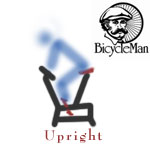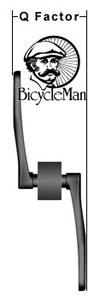Upright stationary exercise bikes have been around a long time but recumbent stationary exercise bikes have become very popular. And there is no doubt that you can readily find someone willing to debate which type of exercise & fitness bike is the “Best Exercise & Fitness Bike.”
Upright Stationary Exercise Bikes vs. Recumbent Stationary Exercise Bikes
While each type of exercise & fitness bike has its’ advantages and/or disadvantages I believe it depends on your personal riding needs and fitness & rehab needs.
Personally, I put my Physical Rehabilitation and Physical Therapy (PT) needs ahead of my thoughts about what a bike should look like. This is why I prefer the recumbent exercise and fitness bikes over the upright exercise bikes. Recumbent exercise bikes are better suited to help me achieve my fitness, PT and Rehab goals.
Let’s go over a few benefits of recumbent exercise bikes:
The recumbent exercise and fitness bike is far more ergonomic & bio-mechanically correct frame and handlebar design:
Recumbent exercise bike riders train in the optimum training position for maximum fitness results. For example; our XTerra Fitness SB-540R recumbent fitness bike is also equipped with an anatomically designed saddle for peak comfort at all times which in turn leads to a more comfortable cardiovascular & rehab workout.
Look at the diagram below and you’ll see the benefits of recumbent exercise bikes; the ergonomics, the bio-mechanics and anatomical design:
For the sake of comparison, we’ll take a brief look at the two different types of stationary indoor bikes; the upright stationary exercise bike compared to a recumbent stationary exercise bike.
Seat & Pedals in Red
Rider Position in Blue
Upright Exercise & Fitness Bike
Recumbent Exercise & Fitness Bike
Upright bikes having wider Q Factors are less ergonomically correct as they force the rider to pedal at a wider angle from the hip than the natural in-line movement of the legs and feet as we walk normally – taking steps in a narrow and more natural pattern.
Proper Seat Adjustment
With your heel on the pedal your leg should be straight or a bit over extended. Then you pedal with the ball of your foot on the pedal and there is a bit of flex left in your knee.
- Pain in the front of your knee usually means too much leg bend.
- Pain in the back (rare) usually means to little bend.
Now, this is not to say that upright exercise bikes are without merit. Upright bikes still have their place in the exercise and fitness market.
There are those who would argue that upright stationary bikes offer a more “intense” workout simply because recumbent stationary exercise bikes are more comfortable. The thinking behind this argument is that if a rider is more comfortable on a recumbent bike; they may not push themselves as hard to achieve the desired fitness levels.
I would say this in response to that theory…
Riders who desire to push themselves to the maximum level of performance can and will do so no matter what type or style of exercise equipment they choose to use.
Why not be comfortable while you are exercising so you can do your very best toward realizing your fitness and rehab goals?
In fact, whether you are:
- An athlete in training looking for a stamina building recumbent bike,
- An off season cycling enthusiast looking for a fitness cycle,
- A PT – Rehab patient recovering from an injury or surgery looking for a belt driven, magnetic recumbent exercise bike for smoothness and reliability,
- Or just trying to lose some weight and tone your body
The support and comfort offered while sitting in a a reclined – recumbent seat position may very well enable you to cycle for longer than you might do on an upright, thus getting a better workout and achieving your fitness and/or rehab goals.
No matter which type of bike you are considering – test ride if at all possible and take your time doing so. The more comfortable you are with your stationary exercise bike ~ the more comfortable you will be using it. And that is what matters most.
 Bicycle Man
Bicycle Man 


